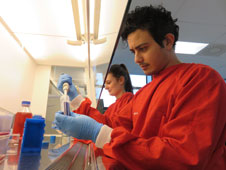 Wednesday 30 November 2016 10:51am
Wednesday 30 November 2016 10:51am
Postgraduate students Bailey Kennedy and Remy Muhsin, who undertook the research with Associate Professor McLellan. Photo credit: Amy Dunn.
Chemotherapy stimulates the release of tiny bubbles from the surface of cancer cells that cause potentially fatal blood clots, new University of Otago research has found.
Most deaths from cancer are caused by uncontrolled growth of the tumour in vital organs. However, the second most common way that cancer kills is by triggering blood clotting resulting in thrombosis, such as pulmonary embolisms.
This causes blockage of major blood vessels – preventing oxygen and nutrients from reaching vital organs. Though often life-saving and life-prolonging, chemotherapy is associated with a six to sevenfold increase in the risk of thrombosis in cancer patients.
The link between cancer and thrombosis was noted over 100 years ago, but the reasons for the association have been elusive.
Microbiology and Immunology Associate Professor Alex McLellan says his team discovered cancer cells treated with chemotherapy release lipid-rich bubbles from their membranes that activate coagulation (clotting) processes.
“We now have insight into how these bubbles from dying cancer cells may cause thrombosis during chemotherapy,” Associate Professor McLellan says.
The work has formed the main topic of a PhD thesis carried out by Remy Muhsin – and was also recently published in the international peer-reviewed journals Biochimica et Biophysica Actaand Oncotarget.
The research has demonstrated that certain solid cancers are more active in promoting blood coagulation, as compared to lymphomas. “A general pattern is that cancers such as pancreatic, lung and brain cancers carry the largest risk of thrombotic events,” he says.
The group analysed the contribution of individual coagulation factors to the risk. Although their work identified the coagulation factor Factor V on the cancer bubbles, it was not essential for the rapid clotting induced by the bubbles. Instead an over-abundance of clotting lipids and a molecule called Tissue Factor on the cancer bubbles were responsible.
“Since cancer-induced coagulation events also encourage tumour progression, our work opens up the possibility of developing inhibitors to the major coagulation pathway identified in cancer cells. The coagulation factors identified may be the Achilles heel of the cancer. Our current work is exploiting these molecules as targets for cellular and drug-based therapies,” he says.
Another Otago study – a collaboration between Professor Sally McCormick of the Department of Biochemistry and Dr Lynnette Jones of the School of Physical Education, Sport and Exercise Sciences – has shown that some chemotherapy agents produce unfavourable changes to blood lipids in breast cancer patients, which may increase the risk of cardiovascular disease. The work, published in the journal PLOS ONE this year, was contributed to by PhD student Monika Sharma and researchers at Dunedin Hospital.
Both Associate Professor McLellan and Professor McCormick are quick to point out that the benefits of chemotherapy far outweigh possible risks of cardiovascular diseases and thrombosis.
“However, while chemotherapy can be lifesaving, it does carry some risks. A new challenge is being able to identify those patients most at risk and providing effective management to mitigate this risk,” they say.
For more information, contact:
Associate Professor Alex McLellan
Department of Microbiology & Immunology
University of Otago
Tel 03 479 7728 (Office) / 03 479 7147 (Lab)
Email alex.mclellan@otago.ac.nz
A list of Otago experts available for media comment is available elsewhere on this website.
Electronic addresses (including email accounts, instant messaging services, or telephone accounts) published on this page are for the sole purpose of contact with the individuals concerned, in their capacity as officers, employees or students of the University of Otago, or their respective organisation. Publication of any such electronic address is not to be taken as consent to receive unsolicited commercial electronic messages by the address holder.
